The 1955 Fiat 600, a tiny car with a big impact, emerged at a pivotal moment in Italy’s post-war recovery. This compact marvel, designed by Dante Giacosa, was more than just transportation; it embodied the aspirations of a nation on the rise.
The Fiat 600 became synonymous with the “Miracolo Italiano,” the economic boom that transformed Italy from a war-torn country to a leading industrial power. Its affordability, fuel efficiency, and innovative rear-engine design resonated with a generation seeking mobility and a taste of the good life.
The Fiat 600’s influence extended far beyond Italy’s borders. Its success paved the way for a new era of small, affordable cars, inspiring generations of car manufacturers to embrace compact designs and efficient engineering. The car’s iconic status was solidified by its appearances in films and popular culture, solidifying its place as a symbol of Italian ingenuity and style.
Historical Context: 1955 Fiat 600
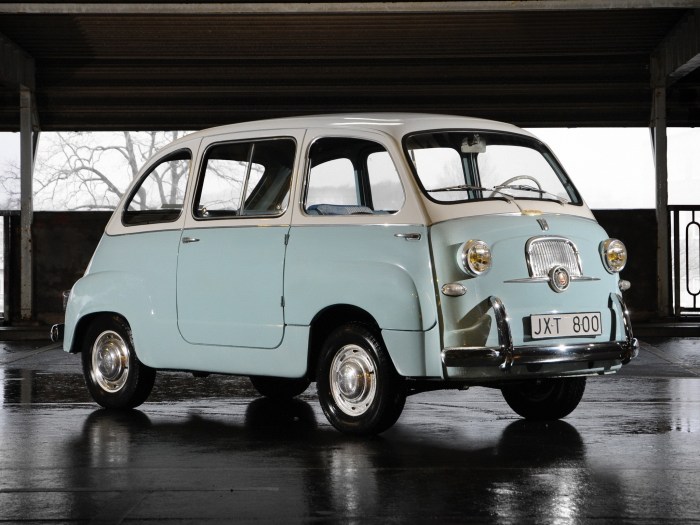
The Fiat 600 emerged during a period of significant social and economic transformation in Italy. Post-World War II, the nation was grappling with widespread poverty, unemployment, and a devastated infrastructure. However, the 1950s witnessed a remarkable economic recovery, fueled by industrialization and a surge in consumer demand.
This period, known as the “Miracolo Italiano” (Italian Miracle), saw a dramatic rise in living standards and a burgeoning middle class.The Fiat 600 played a pivotal role in this economic resurgence. It was a small, affordable car designed specifically to meet the needs of a rapidly expanding middle class.
The Fiat 600 became a symbol of the “Miracolo Italiano,” embodying the aspirations of a nation seeking economic prosperity and social mobility.
The Fiat 600’s Role in the Italian Economic Boom
The Fiat 600’s affordability and practicality made it accessible to a wide segment of the population. The car’s small size and fuel efficiency were particularly appealing in a country with limited resources and a growing need for personal transportation.
The Fiat 600 became the “people’s car,” a symbol of the Italian economic miracle. It facilitated personal mobility, boosted tourism, and contributed to the growth of a consumer culture.The Fiat 600 also had a significant impact on the Italian automotive industry.
The 1955 Fiat 600 was a groundbreaking car, making affordable transportation accessible to a wider audience. Its success paved the way for Fiat’s future models, including the 1975 Fiat 124 , which built upon the 600’s legacy with a larger size and more powerful engine.
While the 124 offered a more refined experience, the 600 remains an iconic symbol of Fiat’s ingenuity and its impact on automotive history.
It was a major success story, boosting Fiat’s production and profits. The car’s popularity helped to establish Italy as a major automotive player on the global stage.
Comparison to Other Popular Cars of the Era
The Fiat 600 stood out from other popular cars of the era, such as the Volkswagen Beetle and the Citroën 2CV, due to its unique features and significance.
- Design and Functionality:While the Beetle and 2CV were known for their simple, utilitarian designs, the Fiat 600 offered a more stylish and modern aesthetic. Its compact size and four-door configuration provided practicality and comfort, making it suitable for both urban and suburban environments.
- Engine Performance:The Fiat 600’s small engine provided decent performance and fuel efficiency, making it a cost-effective option for everyday driving. It offered a balance between performance and economy that was attractive to a wide range of buyers.
- Cultural Impact:The Fiat 600 became a symbol of Italian design and engineering excellence. Its popularity helped to solidify Italy’s reputation as a leader in the automotive industry. The car’s widespread adoption also contributed to the growth of a vibrant Italian car culture.
Design and Engineering
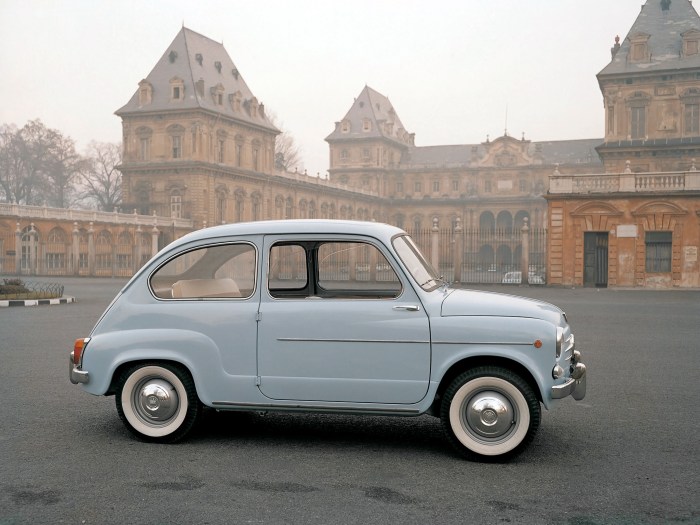
The Fiat 600, a symbol of Italian ingenuity and the democratization of car ownership, was a revolutionary design that challenged conventional automotive thinking. Its compact size, rear-engine layout, and innovative engineering solutions combined to create a car that was both affordable and practical, making it a huge success in the post-war era.
Design Features
The Fiat 600’s design was a masterpiece of simplicity and efficiency. Its compact dimensions, with an overall length of just 3.2 meters, made it ideal for navigating narrow streets and tight parking spaces. The car’s rear-engine layout, a bold choice at the time, offered several advantages.
It allowed for a spacious passenger cabin, with the engine positioned behind the rear axle, and contributed to the car’s impressive maneuverability. The engine, a 633 cc air-cooled four-cylinder unit, was designed to be compact and efficient, delivering a surprising amount of power for its size.
Influence on Subsequent Small Car Designs
The Fiat 600’s influence on subsequent small car designs was profound. Its rear-engine layout, which was considered unconventional at the time, became a popular choice for compact cars, particularly in Europe. The car’s innovative engineering solutions, such as its unibody construction and independent suspension, inspired generations of car designers.
The Fiat 600’s success paved the way for the development of other small, affordable cars, such as the Renault 4 and the Volkswagen Beetle, which went on to become global automotive icons.
Comparison with Competitors
The Fiat 600 was a game-changer in the small car segment, offering a compelling combination of affordability, practicality, and performance. The table below compares the Fiat 600’s specifications to its main competitors at the time:
| Feature | Fiat 600 | Volkswagen Beetle | Renault 4 |
|---|---|---|---|
| Engine Size | 633 cc | 1192 cc | 747 cc |
| Power Output | 19 hp | 25 hp | 23 hp |
| Top Speed | 85 km/h | 100 km/h | 90 km/h |
| Fuel Economy | 28 km/l | 22 km/l | 25 km/l |
| Price | Lower | Higher | Similar |
The Fiat 600’s strengths lay in its compact size, affordable price, and impressive fuel economy. While its power output was lower than its competitors, it was still sufficient for city driving and offered a fun driving experience.
Production and Marketing
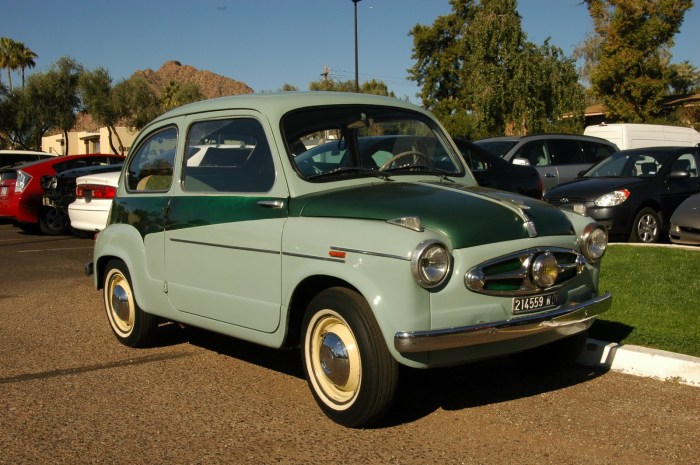
The Fiat 600’s success was not only due to its innovative design but also to its efficient production and clever marketing strategies. Fiat’s ability to produce the car in large numbers at a low cost, coupled with its targeted marketing approach, made the 600 a household name across Europe and beyond.
Production Process
The Fiat 600 was manufactured at Fiat’s Mirafiori plant in Turin, Italy, using a highly efficient assembly line process. The car’s design was simple and modular, allowing for easy and rapid assembly. The use of advanced manufacturing techniques, such as the introduction of automated welding and painting processes, further streamlined production.
- Assembly Line:The Fiat 600’s production process was highly streamlined and efficient, with a focus on minimizing waste and maximizing output. The car’s simple design and modular construction allowed for easy assembly, with workers specializing in specific tasks along the assembly line.
- Manufacturing Techniques:Fiat employed a range of advanced manufacturing techniques to improve efficiency and reduce production costs. These included automated welding, painting, and other processes that helped to speed up production and ensure consistent quality.
- Materials:The Fiat 600 was designed to be affordable, and this was reflected in the choice of materials. While the car featured a steel body, it also used a significant amount of lightweight materials, such as aluminum and plastics, to keep the weight down and production costs low.
The 1955 Fiat 600, a small and affordable car, played a significant role in popularizing automotive transportation in post-war Europe. It paved the way for future Fiat models like the 1982 Fiat 124 , which continued the legacy of compact, fuel-efficient cars, but with a more refined and modern design.
Despite its later release, the 1982 Fiat 124 still carries the spirit of the original 600, proving that Fiat’s dedication to creating accessible and practical vehicles has remained consistent throughout the years.
Marketing Strategies
Fiat’s marketing campaign for the 600 was focused on its target audience: young, urban families and individuals seeking affordable and practical transportation. The company employed a range of strategies to reach this audience, including:
- Advertising:Fiat used a variety of advertising mediums to promote the 600, including print ads, television commercials, and radio spots. The ads often featured the car’s affordability, practicality, and stylish design.
- Media Relations:Fiat also engaged in extensive media relations activities to generate positive publicity for the 600. The company invited journalists to test drive the car and attend press conferences, which helped to build awareness and generate positive reviews.
- Target Audience:The Fiat 600 was marketed towards a specific target audience: young, urban families and individuals seeking affordable and practical transportation. The car’s affordability, practicality, and stylish design appealed to this demographic.
Versions and Models
The Fiat 600 was produced in a variety of versions and models over its lifespan, each with its own unique features and target market.
- Fiat 600 (1955-1969):The original Fiat 600 was a two-door, four-seater hatchback. It was powered by a 633 cc engine and offered a range of body styles, including a sedan, a convertible, and a station wagon.
- Fiat 600D (1960-1969):The Fiat 600D was a more powerful version of the original 600, featuring a larger 767 cc engine. It was also available in a wider range of body styles, including a commercial van and a pick-up truck.
- Fiat 850 (1964-1972):The Fiat 850 was a larger and more powerful version of the 600, featuring a 843 cc engine. It was available in a variety of body styles, including a sedan, a coupe, a station wagon, and a spider convertible.
- Fiat 600 Multipla (1956-1960):The Fiat 600 Multipla was a unique version of the 600 that featured a distinctive three-row seating arrangement. It was designed to accommodate up to six passengers, making it a popular choice for families and businesses.
Cultural Impact
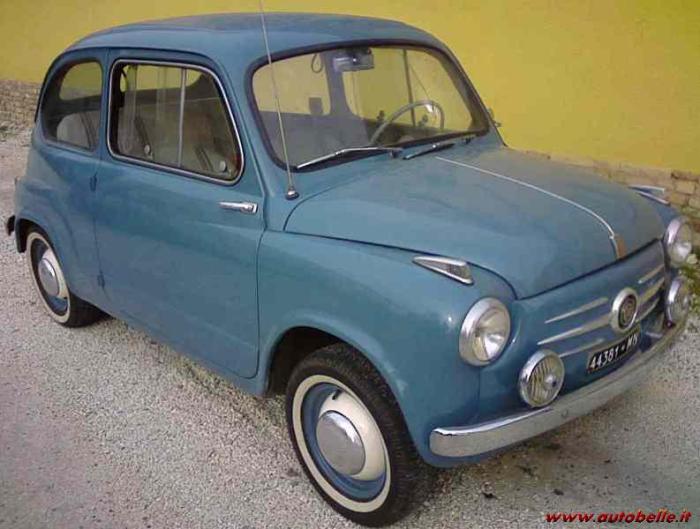
The Fiat 600’s impact transcended its role as a mere vehicle; it became a cultural icon, deeply embedded in the fabric of Italian society and resonating across the globe. Its enduring popularity is a testament to its versatility, affordability, and the way it mirrored the aspirations and changing lifestyles of the time.
The Fiat 600’s Influence on Italian Society
The Fiat 600 played a pivotal role in the transformation of Italian society, contributing significantly to increased mobility, leisure, and a shift in lifestyle. The car’s affordability made personal transportation accessible to a broader segment of the population, empowering individuals to travel beyond their immediate surroundings and explore new horizons.
This newfound freedom led to a surge in domestic tourism, with families embarking on weekend getaways and summer vacations. The Fiat 600 became synonymous with the Italian “dolce vita,” a symbol of newfound prosperity and the pursuit of pleasure.
The 1955 Fiat 600, a compact and affordable city car, marked a turning point for Fiat, becoming a global success story. While the 600 was a practical and economical vehicle, Fiat also ventured into the realm of sporty roadsters with the 1982 Fiat Spider , a sleek and stylish convertible that captured the essence of Italian automotive design.
The 600’s legacy, however, continued to influence Fiat’s design philosophy, leading to the development of even more innovative and iconic models.
- Increased Mobility:The Fiat 600 democratized car ownership in Italy, allowing families and individuals to travel more freely. This led to a rise in domestic tourism and a shift in leisure activities, as people could now easily explore the Italian countryside and coast.
- Leisure and Recreation:The Fiat 600’s compact size and maneuverability made it ideal for navigating crowded city streets and winding country roads. It facilitated weekend getaways to beaches, mountains, and other scenic destinations, becoming a symbol of leisure and escapism.
- Changing Lifestyles:The Fiat 600’s affordability and practicality contributed to a shift in Italian lifestyles. It allowed families to live further away from city centers, enabling suburban development and a more relaxed way of life.
Legacy and Influence
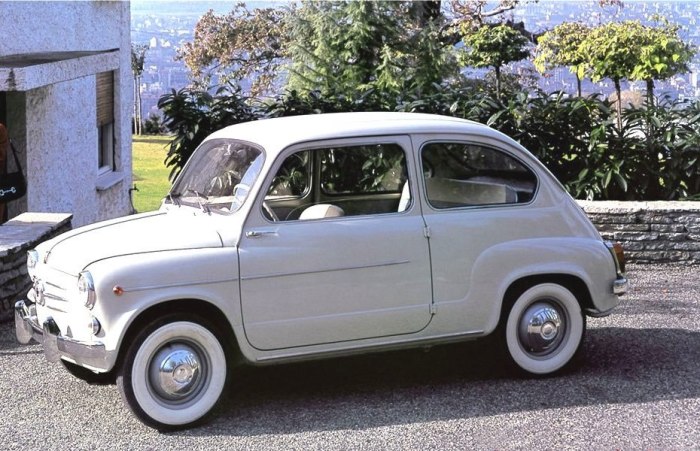
The Fiat 600, a symbol of Italian ingenuity and postwar economic recovery, left an indelible mark on the automotive landscape. Its impact extended beyond its commercial success, influencing the development of subsequent small cars and contributing to a global shift towards affordable, fuel-efficient vehicles.
Impact on Small Car Development, 1955 Fiat 600
The Fiat 600’s influence on the development of small cars is undeniable. Its compact design, rear-engine layout, and affordability set a new standard for the segment, paving the way for a new generation of economical and practical vehicles. The car’s success inspired numerous other manufacturers to develop similar models, contributing to the rise of the small car segment as a significant force in the global automotive market.
- The Fiat 600’s compact design and rear-engine layout, inspired by the Volkswagen Beetle, became a blueprint for many subsequent small cars, such as the Renault 4, the Citroën 2CV, and the BMC Mini.
- The car’s affordability and fuel efficiency made it a popular choice for families and individuals on a budget, contributing to the growing demand for small cars in Europe and beyond.
- The Fiat 600’s success helped to establish the small car segment as a viable and profitable market for automakers, leading to increased investment and innovation in this sector.
Influence on Car Design and Engineering
The Fiat 600’s influence on car design and engineering is multifaceted. Its innovative features, such as its rear-engine layout and its use of lightweight materials, paved the way for new design and engineering solutions in the automotive industry.
- The Fiat 600’s rear-engine layout, while not entirely new, gained widespread popularity with the car’s success, influencing the design of other small cars, such as the Renault 4 and the Citroën 2CV.
- The car’s use of lightweight materials, such as aluminum and fiberglass, helped to reduce its weight and improve its fuel efficiency, setting a trend for subsequent small cars.
- The Fiat 600’s innovative design, which prioritized practicality and affordability, influenced the development of subsequent small cars, leading to a shift towards more functional and efficient vehicles.
Production Lifespan and Impact
The Fiat 600’s production lifespan, from 1955 to 1969, witnessed the evolution of the car and its impact on the automotive industry. The car’s various models, including the Fiat 600D, the Fiat 600 Multipla, and the Fiat 850, each contributed to the car’s enduring legacy.
| Year | Model | Impact |
|---|---|---|
| 1955 | Fiat 600 | Introduced the rear-engine layout and set a new standard for small cars. |
| 1957 | Fiat 600D | Introduced a more powerful engine and a larger luggage compartment. |
| 1959 | Fiat 600 Multipla | Introduced a unique minivan design with three rows of seats, showcasing the car’s versatility. |
| 1964 | Fiat 850 | Introduced a larger engine and a more modern design, expanding the Fiat 600’s appeal to a wider audience. |
| 1969 | End of production | The Fiat 600’s production ended, leaving behind a legacy of innovation and influence on the automotive industry. |
Final Thoughts
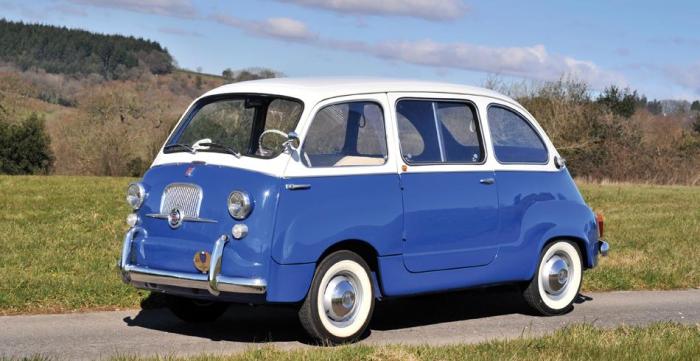
The 1955 Fiat 600, a car born out of necessity and ingenuity, left an indelible mark on the automotive landscape. It transcended its role as a mere mode of transport, becoming a cultural icon, a symbol of hope, and a testament to the power of innovation.
Its legacy continues to inspire car designers and manufacturers today, reminding us that even the smallest of vehicles can have a profound impact on the world.